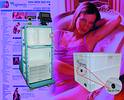

Texas Instruments’ radio frequency identification (RFID) technology has been chosen to streamline the picking and shipping of lingerie and underwear for Figleaves, Europe’s leading online underwear e-retailer. Figleaves claims the new system which combines hardware, software and underwear, is “the most efficient e-fulfilment solution to hit the ‘e-tail’ market in years”.
Figleaves.com is a new breed of online retailer experiencing unprecedented demand for Internet shopping for a wide range of lingerie and underwear for both men and women. With over 70 well-known brands and thousands of products, the London-based business needed a new order fulfilment system that would allow them to dramatically increase their efficiency and expand its Internet sales handling capacity.
"We could not have provided Figleaves with the multitote capability they required for simultaneous order picking without the RFID system," said Roy Allum, MD of Microlise Group who supplied the overall system. "TI's transponders allow us to identify each tote and instantly associate it with the computer generated pick list at both the picking trolley and at the packing benches. The increased accuracy means Figleaves no longer has to carry out time-consuming post-checking which cuts cost and improves efficiency while ensuring that customers get the right products first time," he added.
The Figleaves.com project demanded some fresh thinking. The problem was how to pick as many orders as possible at once without introducing errors and guaranteeing accuracy. Figleaves worked with leading warehouse management specialist, Microlise Systems Integration, to provide a complete solution based on their OPUS warehouse management software. The software allows the picker to efficiently assemble up to 24 orders into a single trolley by choosing the optimal pick sequences to minimise walking distances in a single pass with total accuracy.
At the heart of the system are Microlise's radio-linked intelligent 'lighted' trolleys, each of which can carry three tote boxes. Each tote box has up to eight compartments, allowing a total of 24 orders to be processed simultaneously. Each of the three tote boxes features a unique RFID transponder which is read by one of the three RFID readers fitted to the trolley to identify the tote box, what type it is, how many compartments it has, and associate it with the appropriate picking list.
All the picking instructions are downloaded to the high-tech picking trolley using the built-in radio terminal with graphics display. The picker follows the displayed picking instructions and batch picks products for up to 24 orders using a barcode scanner to confirm the correct products.
The really clever part, according to the company, is that each tote compartment has a numeric display next to it that shows the exact quantity of each product to go into each of the 24 compartments. The operator simply picks the correct number of items into the appropriate lighted compartment and confirms correct placement of each item by pressing a touch button associated with the numeric display.
A similar RFID identification system is also used at the packing benches. When all the pick operations for a trolley are complete, the tote boxes are delivered to a packing bench equipped with RFID readers which identify each tote and associate it with the order. Once identified, a matrix of lights adjacent to each tote compartment then shows exactly which compartment the products should be taken from for each order, and put in the correct box for shipment. The OPUS software advises the packer via the display of any special instructions such as orders awaiting products which have been picked in a different zone of the warehouse, or any special instructions such as personal messages, special packaging requests etc. Once the order is complete and in the box, the system prints a delivery note and label and the boxes are then sent to the mail sort.
Another major advantage for Figleaves is that the system captures data in realtime as soon as each physical activity is carried out, allowing detailed progress reporting and performance analysis resulting in measurable efficiency gains for this forward thinking e-retailer.
"Figleaves had already developed its own software based on Microsoft Access which was successful on a smaller scale," says Daniel Nabarro, Figleaves Chairman and Founder. "However, as orders grew, we knew we needed a more sophisticated system that could support picking of multiple orders simultaneously with minimum walk distances in order to eliminate wasted time and improve efficiency. The problem was how to pick multiple orders simultaneously without generating lots of errors. The breakthrough was to integrate RFID into the intelligent lighted trolley system to provide automatic identification resulting in the higher picking accuracy we needed. This has been so successful that we have been able to completely eliminate the usual time-consuming post checking procedures as there are no errors, saving time and cost and ensuring our customers get the right products first time."
| Tel: | +27 11 923 9600 |
| Email: | [email protected] |
| www: | www.altronarrow.com |
| Articles: | More information and articles about Altron Arrow |

© Technews Publishing (Pty) Ltd | All Rights Reserved